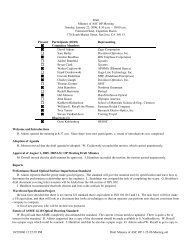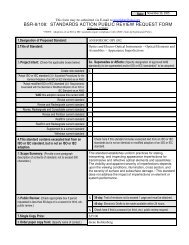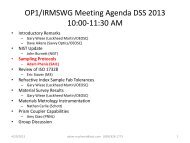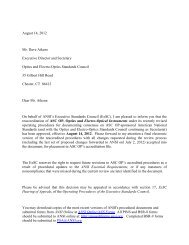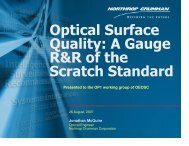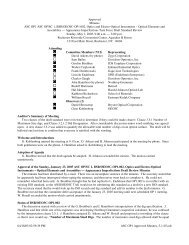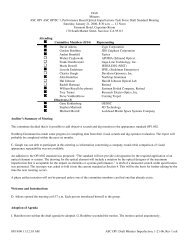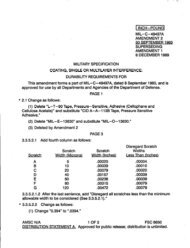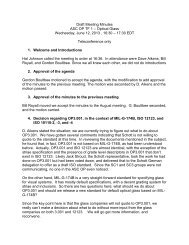INCH-POUND MIL-PRF-13830B 9 January 1997 SUPERSEDING ...
INCH-POUND MIL-PRF-13830B 9 January 1997 SUPERSEDING ...
INCH-POUND MIL-PRF-13830B 9 January 1997 SUPERSEDING ...
Create successful ePaper yourself
Turn your PDF publications into a flip-book with our unique Google optimized e-Paper software.
<strong>MIL</strong>-<strong>PRF</strong>-<strong>13830B</strong><br />
APPENDIX E<br />
coated on one side with the sealing compound to a thickness of (0.0625 in. (0.16 cm).<br />
The panels shall be immersed for 48 hours at 38°C “ 1°C (100° “ 2°F) in so that one<br />
half of the material is above the liquid level. The panels shall then be removed, air<br />
dried for 24 hours, and baked at 82° “ 1°C (180° “ 2°F) for 72 hours. The panels<br />
shall then be examined for changes in film properties. Visible evidence of change in<br />
the film property shall constitute failure of this test. Failure of the sample shall be<br />
cause for rejection of the lot (see E.3.10).<br />
E.4.5.10 Water vapor permeability. A sufficient amount of sealing compound<br />
shall be pressed between two sheets of polyethylene film (0.003-0.004 inches thick),<br />
according to ASTM D4397 to form a film about 0.075 in. (0.19 cm) thick and 2 in.<br />
(5.0 cm) in diameter. One of the polyethylene sheets shall be peeled off and a<br />
suitable size screen which shall retain the sealing compound shall be placed on the<br />
sealing compound. Use 2.5 inch (6.3 cm) diameter 30 mesh plain weave screening<br />
with 0.010 inch (0.025 m) diameter wire made of type 5056 aluminum or brass,<br />
according to ASTM E437. The polyethylene sheet shall be placed on the screen and<br />
the assembly shall be compressed until the overall thickness of the sealing<br />
compound and the screen is 0.064 “ 0.002 in. (0.16 “ 0.01 cm). The polyethylene<br />
sheets shall be removed and the screen-supported film shall be trimmed to size and<br />
placed in a position as shown in figure 4E. 5 ml of distilled water shall be placed in a<br />
Petri dish. The two metal plates holding the film of sealing compound and the Petri<br />
dish shall be screwed tightly to insure a good seal between the edge of the Petri dish<br />
and the sealing material (see E.3.11).<br />
E.4.5.10.1 Assemblies. Two assemblies shall be prepared as described in<br />
E.4.5.10. A third assembly shall be prepared in the same manner except that no<br />
water shall be placed in the Petri dish. The three assemblies shall be weighed to the<br />
nearest 0.001 grams and then placed in an oven at 71° “ 1°C (160° “ 2°F) for 4<br />
hours. The loss in weight of the dry assembly shall be subtracted from the weight of<br />
each of the other two assemblies. The water vapor transmission rates shall be<br />
calculated in units of g of water/hr/in.ì of open area. The open area is the area of the<br />
1.875 in-hole in the metal plate minus the area occupied by the wires of the screen<br />
within the hole. Failure of either sample shall be cause for rejection of the lot.<br />
Percent of water vapor is calculated as follows:<br />
wt of (sample + water + dish) X 100<br />
wt of dish<br />
conducted at 1 hr intervals until constant weight.<br />
E.4.5.11 Color. The material shall be visually examined for conformance to color<br />
75<br />
Source: http://www.assistdocs.com -- Downloaded: 2006-05-24T15:32Z<br />
Check the source to verify that this is the current version before use.



